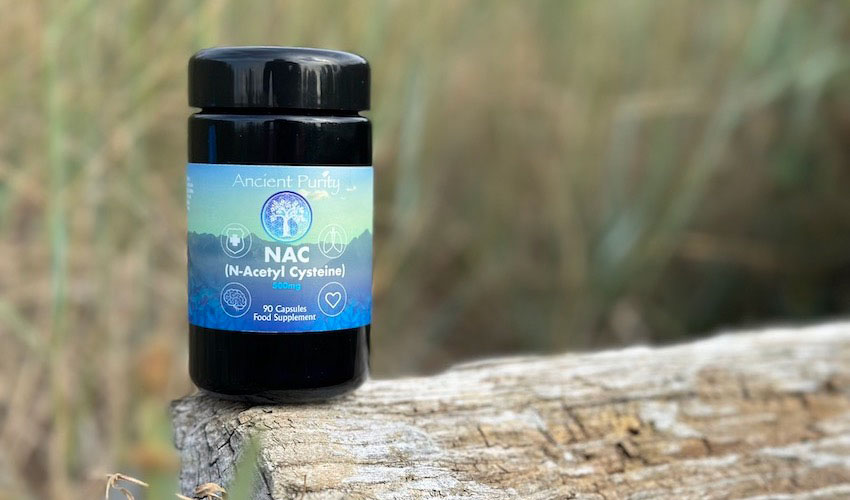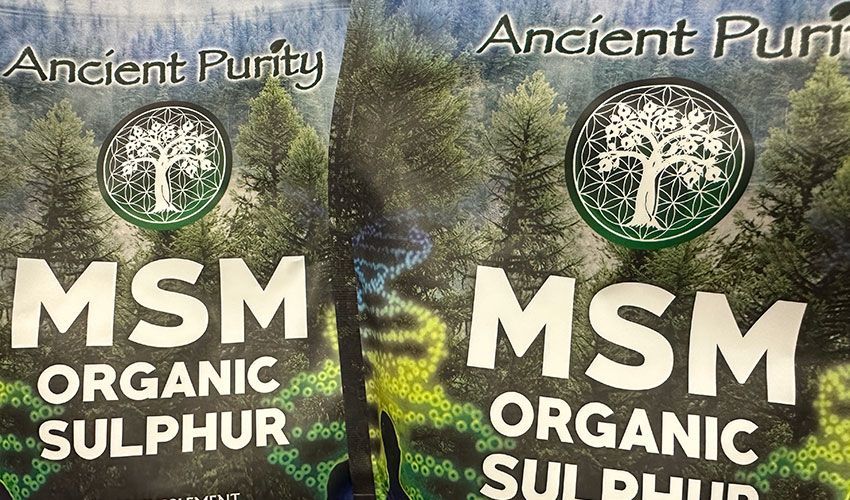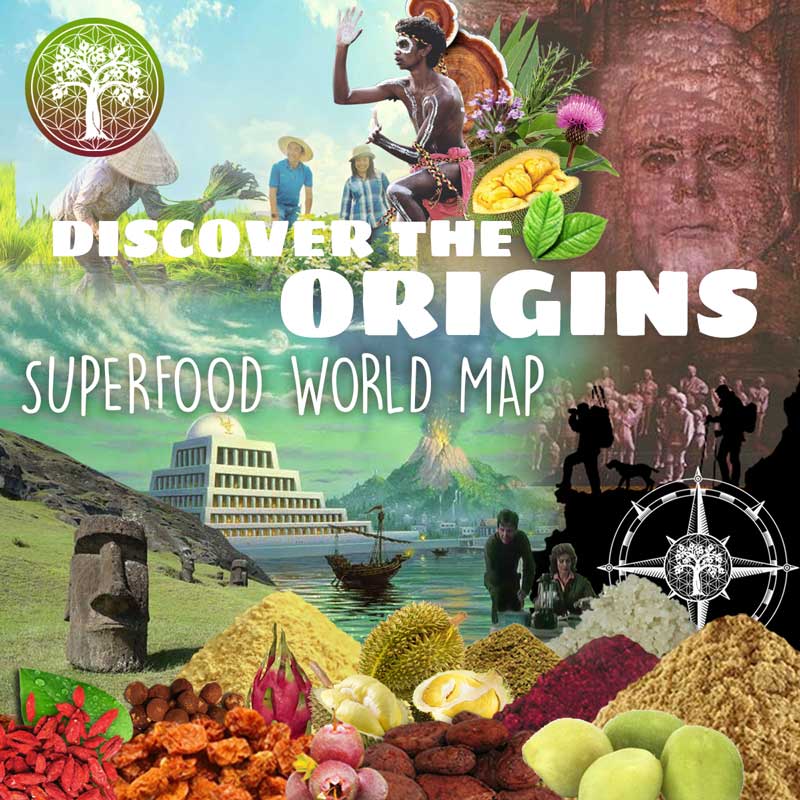MSM Organic Sulphur - Diving Deep into Real MSM
Recently I’ve studied extensive scientific research reports about MSM Organic Sulphur and today I dive into the deep and mysterious world of elemental Sulphur and its role in human nutrition. As always, I like to explain things in a witty way so you won’t stop reading after the first paragraph. While it may not have received much attention in the past, I’m here trying to shed some light on this sulphuric superstar and explore its potential therapeutic applications in medicine. Now, get ready for some mind-blowing facts. Did you know that Sulphur is not only the sixth most abundant macro-mineral in breast milk but also the third most abundant mineral in terms of total body weight? Yes, Sulphur really knows how to make its presence known.
Even more fascinating are the Sulphur-containing amino acids (SAAs). These little guys go by names like methionine, cysteine, and Taurine, and they play a crucial role in our diet. So, if you happen to be a vegan athlete, a kid, or someone with HIV, you might want to pay extra attention to your SAA intake to avoid any deficiencies. It's like giving your body a VIP pass to the Sulphur party. Now, let's talk about this thing called methylsulfonylmethane (MSM), which sounds like something out of a science fiction movie. But no, it's actually a fancy name for a Sulphur compound found in our diet. It turns out that MSM, along with its buddies DMSO and glucosamine sulphate might be responsible for some pretty cool therapeutic effects. So, next time someone asks why you're loading up on MSM, just tell them you're on a quest for pain relief, allergy treatment, or even bladder disorder conquest. It's all about embracing the power of Sulphur!

Oh, and did I mention that Sulphur can also be used to boost the synthesis of S-adenosylmethionine (SAMe), glutathione (GSH), taurine, and N-acetylcysteine (NAC)? Talk about a Sulphur superstar line-up! In addition, we've got a whole crew of Sulphur compounds, like SAMe, dimethylsulfoxide (DMSO), taurine, glucosamine sulphate, and reduced glutathione, who are itching to show off their clinical applications. From treating depression, fibromyalgia, and arthritis to help tackling conditions like congestive heart failure, diabetes, the growth of abnormal cells, and AIDS, these Sulphur superheroes are ready to save the day. And these Sulphur compounds have pretty low toxicological profiles, which makes them even more appealing. Combined with their promising therapeutic effects, it's clear that we need to keep exploring their potential through rigorous human clinical trials. Cheers to the power of the sixth most abundant macro-mineral and all it has in store for us!
Sulphur Sources
We've got some amino acid celebrities in town! Methionine and cysteine, the organic Sulphur complexes of the body, are the rock-stars that meet our Sulphur needs. But not all proteins are created equal in the Sulphur department. Animal and cereal proteins are basically like VIPs with their higher levels of Sulphur-containing amino acids, while legume proteins are more like the cool kids sitting in the back. And when it comes to the methionine to cysteine ratio, animal proteins are the winners, always higher than their plant counterparts. Methionine is like the boss of the Sulphur game. It can give some of its Sulphur to cysteine through a fancy pathway called trans sulphuration. What about cysteine? Nope, it can't do the reverse. It is like cysteine is always living in the shadow of methionine.
<pnow, here's="" where="" things="" get="" interesting.="" low-sulphur="" soils="" are="" a="" thing="" in="" some="" parts="" of="" the="" world,="" like="" pacific="" northwest="" and="" great="" lakes="" region="" usa.="" but,="" no="" need="" to="" worry="" as="" glutathione="" is="" here="" save="" day.="" fruits="" veggies="" mvps="" when="" it="" comes="" dietary="" glutathione,="" while="" meats="" more="" gently="" tapping="" backup="" dancers.="" who="" knew="" that="" sulphur="" would="" hide="" such="" unexpected="" places?="" turns="" out,="" there="" sneaky="" compounds="" sulphate="" sulfoesters="" contribute="" extravaganza.="" they="" might="" not="" much="" credit="" nutrition="" textbooks,="" but="" can="" actually="" do="" serious="" amino="" acid="" bioactivity.="" even="" spare="" for="" methionine="" cysteine="" our="" diets.="" take="" that,="" textbooks!<="" p="">
Now, here's where things get interesting. Low-Sulphur soils are a thing in some parts of the world, like the Pacific Northwest and the Great Lakes region in the USA. But, no need to worry as glutathione is here to save the day. Fruits and veggies are the MVPs when it comes to dietary glutathione, while meats are more like the gently tapping backup dancers. Who knew that Sulphur would hide in such unexpected places? Turns out, there are sneaky Sulphur compounds like sulphate and sulfoesters that contribute to the Sulphur extravaganza. They might not get much credit in the nutrition textbooks, but they can actually do some serious amino acid bioactivity. They can even spare the need for methionine and cysteine in our diets. Take that, textbooks!

Now, let's talk numbers (I know, this can be boring). The Recommended Daily Allowance committee suggests we should be getting at least 13 mg of Sulphur amino acids per kilogram of body weight per day. That's about 910 mg for a 70 kg adult. But some fancy authorities believe we should aim higher, around 25 mg/kg/day. Basically, we need to make sure we're getting enough of these amino acid rock-stars. And here's a little tip - if you're looking for maximum bang for your protein buck, animal protein is where it's at (Sorry vegans). It has a higher net protein utilisation factor and more protein by weight than most plant foods. So, vegans out there, you might need to be a bit more cautious about getting enough of those Sulphur amino acids. But wait, not all hope is lost for the plant eaters. There are some plant foods that are rocking the Sulphur game. Corn, sunflower seeds, oats, and even chocolate have high levels of methionine. And if you're a fan of cashews, walnuts, almonds, or sesame seeds, you're in luck too. They've got your cysteine needs covered. Who knew plants could bring their A-game in the Sulphur department? Sulphur might not be the sexiest topic, but it sure knows how to make an impact. From amino acid superheroes to sneaky compounds and rock-star plant foods, Sulphur is here to make sure our bodies get what they need.
Overtraining
When athletes push their bodies too hard, it's like they are giving themselves a little beat-down. Not only does it mess with their plasma glutathione levels and make them pee out more sulphate, but it also breaks down their muscles and lowers their plasma GSH. And let's be real, that's not going to help them get stronger. But here's the thing, if these athletes aren't getting enough Sulphur amino acids in their diet, it's going to make things even worse. Because when their intake is low, their bodies are going to prioritise using cysteine for building muscle instead of making more GSH. And we all know that GSH is where it's at. So what's the solution? Well, lucky for them, Raw Whey Protein is packed with cysteine and methionine. And methionine can actually turn into cysteine, which is like a magic trick for maintaining GSH levels. We could even throw in some lipoic acid to help with all the oxidative stress and keep their vitamin E and C levels in check. In a nutshell, athletes, take care of your bodies. It's cool to push yourself, but don't go overboard. And if you wish to keep your muscles and GSH in top shape, fuel up with whey protein, methionine, cysteine, and a side of lipoic acid. You'll thank me later.
Chondroitin Sulphate
You know that fancy acronym, Chondroitin Sulphate? Well, it's basically part of a gang known as GAGs, or polysaccharides. CS is like the cool kid with a clique made up of D-galactosamine and D-glucuronic acid. They hang out in human cartilage, bone, skin, cornea, and even the arterial wall. Talk about being everywhere! If you're looking for CS in your nutritional supplements, you might find it chilling with bovine and pork cartilage, shark cartilage, or even the majestic whale septum. Who knew these sources could be so hip? Now, here's where things get interesting. While glucosamine sulphate is all about building and fixing cartilage, chondroitin sulphate takes a different approach. It's all about retaining water and keeping that cartilage nice and bouncy. Not only that, but it also kicks some serious butt, inhibiting those freaking enzymes that break down cartilage. But hey wait, here's the plot twist. People used to think that chondroitin didn't get absorbed when taken orally. Why? Well, blame it on the molecule's size. It's pretty hefty, weighing in between 5,000 to 50,000 daltons. But guess what? In 1995, some genius researchers discovered that up to 15% of chondroitin actually gets absorbed, molecule intact! That's right, even though it may be a big shot, it still manages to sneak its way into our system.

And here's the kicker. The lighter version of chondroitin, with a molecular weight lower than 16,900 daltons, seems to be the real MVP when it comes to absorption. It's like the chondroitin on a diet, slimming down and getting right to the action. Once chondroitin gets into your system, it's got a major crush on GAG-rich tissues. You'll find it hanging out with the cool kids in the eyes, joints, lumbar disks, and those fancy epiphysis things at the ends of long bones. It's all about going where the party's at! So, next time you hear someone mention Chondroitin Sulphate, you can casually drop some knowledge. It's the groovy polysaccharide with a posse of D-galactosamine and D-glucuronic acid. It's all about water retention and keeping cartilage elastic, while spanking those enzymes that try to break it down. And don't forget, it may be a big shot, but it still knows how to sneak into our system and hit up the coolest spots, where the GAG-rich tissues hang out. Keep it classy, Chondroitin Sulphate!
Cysteine
Cysteine, I like to describe it as the multi-talented superstar as it takes on multiple roles in the body. It's like the Swiss Army knife of amino acids! Firstly, it acts as an extracellular reducing agent, kind of like a superhero that swoops in to save the day and neutralise those damaging free radicals. Secondly, it's an essential ingredient for protein synthesis, the master chef creating the building blocks for muscle growth and repair. But hey, there is more! Cysteine is also the VIP precursor to two important substances: glutathione (aka GSH) and taurine. So not only does it party with antioxidants, but it's also the ultimate VIP guest list for biochemical processes. Now, how can we give cysteine a helping hand? Well, one option is to slip it a sneaky oral dose. This boosts glutathione levels, in turn increasing the body's defence against all the nasty stuff floating around. Plus, it does a great disappearing act with those annoying trace elements in the gut, reducing their absorption. So, in essence, cysteine plays a magician, making sure we only absorb what we need and not the excess.
But that's not all! Cysteine has another trick up its sleeve. When fed to our animal friends chowing down on high levels of copper, it works wonders. It puts those pesky liver copper deposits in their place and even improves their growth. Talk about a win-win! Excessive copper intake messes with using Sulphur amino acids efficiently, so cysteine makes sure that the body gets what it needs. Cobalt and selenium toxicity can also be put in their place by cysteine, but this time it's an oral showdown. Cysteine takes control and neutralises the toxicity, leaving those elements no chance to wreak havoc. But here's the kicker: cysteine can be a little finicky. It doesn't like moisture and loves to oxidise. That's where our trusty sidekick, N-Acetyl Cysteine (NAC), comes into play. NAC is like the bodyguard for cysteine, ensuring it gets safely absorbed without any moisture mishaps. It's the wingman that cysteine needs to shine and do its job effectively. So there you have it, cysteine and NAC, the dynamic duo taking on the role of biochemical superheroes. They work together to keep our bodies in tip-top shape and fight off any nasty intruders.
N-Acetylcysteine (NAC)
N-acetylcysteine, a funky derivative of the Sulphur-containing amino acid cysteine and a real player in the conversion of cysteine to glutathione, is quite the charmer. It's found naturally in food and our bodies, and both NAC and cysteine have these adorable little sulfhydryl groups that just love gobbling up free radicals. When you pop some NAC in your mouth, it boosts your intracellular cysteine and GSH (glutathione) levels like nobody's business. Now, NAC is not only a superhero in the biochemistry world, but it's also the king for acetaminophen poisoning. Forget those damsel-in-distress days, because NAC can significantly reduce them. It can even come to the rescue in cases of chromate or borate intoxication, reversing the nasty oliguria (low urine production) that comes along with it. Pro tip: if you're in a poison jam, go for the IV administration of NAC – nausea and vomiting might just crash the party if you opt for oral therapy.
When N-acetylcysteine is living its best life inside your body, it transforms into L-cysteine, cystine, L-methionine, and glutathione. And it doesn't stop there – L-methionine also joins the party, creating more cysteine and an explosion of glorious glutathione. But here's the twist: HIV-positive people often suffer from dismal GSH and cysteine levels, losing precious Sulphur in the process. Surprisingly, antiviral drugs don't really affect this Sulphur loss, which can contribute to antiviral treatment failure. However, hope shines through as several preliminary clinical trials have shown promising results in treating HIV-positive patients with NAC. Unfortunately, these poor trials don't meet the high standards of health authorities because they were either too puny, too short-lived, lacking proper control, or examined an endpoint that wasn't universally accepted in the survival game. So, there you have it – the delightful tale of N-acetylcysteine, the Sulphur superhero of the amino acid world, saving lives and keeping the biochemistry party going. Learn More About N-Acetylcysteine Here.

Taurine
Taurine is an amino acid that likes to live life on the edge. It's derived from the wild party that is methionine and cysteine metabolism. You'll find this amino acid hanging out in most tissues, especially those rowdy proinflammatory cells and the snazzy retina. Now, picture this – animals and humans who are lacking in taurine start experiencing some serious retinal drama. That's right! Their retinas just can't handle life without a healthy dose of taurine. It's like a jukebox without any good tunes, a party with no dancing. Sad, sad stuff. Except for cow's milk – it's the only one giving taurine the cold shoulder. Taurine knows how to charm its way into foods from various animal sources, but plants are a no-go for this amino acid extraordinaire. And let me tell you, Taurine is no one-trick pony. It's got some serious metabolic skills up its sleeve. Bile acid conjugation? Check. Detoxification? Double check. Membrane stabilisation? You betcha. Osmoregulation? Absolutely. And let's not forget about its party trick – modulating cellular calcium levels. Taurine knows how to keep those cells in check.
Now, here's the thing – taurine is synthesised from some fancy stuff called SAA, but some people are worried that we might not have enough of it, especially those little bundles of joy known as neonates. So, to make sure those cuties get theirTtaurine fix, we've got those fancy pants infant formulas that are all decked out with Taurine supplements. Taurine isn't just some fancy supplement – it's a real-life hero in the world of medicine. Doctors have been using it to battle all sorts of conditions, with varying degrees of success, of course. Cardiovascular diseases, hypercholesterolemia, epilepsy, macular degeneration – you name it, Taurine has been there, giving it its best shot. It's like a cool, mysterious detective taking on case after case, always trying to crack the code and save the day. Taurine may be a mouthful to say, but it's a true rock-star in the world of amino acids. It's got the moves, the style, and the power to make a real difference in the lives of both humans and animals. Long live the mighty Taurine!
Alpha Lipoic Acid (thioctic acid, ALA)
Alpha-Lipoic Acid, the superhero of antioxidants, swoops in to save the day in mitochondrial dehydrogenase reactions, preventing those harmful free radicals from wrecking havoc on our precious cells. This antioxidant powerhouse doesn't stop there! It also takes on the role of a blood sugar slasher and a stress reducer. But, there's even more! Alpha-Lipoic Acid even teams up with its buddies ascorbate and vitamin E to supercharge their antioxidant abilities. Not content with just aquatic adventures, Alpha-Lipoic Acid fearlessly dives into both aqueous and hydrophobic environments, where it flexes its muscles and boosts the levels of coenzyme Q1068 and intracellular GSH69 like an antioxidant champ. And here is the best part. When Alpha-Lipoic Acid is ingested, it undergoes a powerful transformation, becoming the mighty dihydrolipoic acid (DHLA), ready to take on any oxidative damage that comes its way. Lipoic acid is not only a great ally against conditions such as ischemia-reperfusion injury, diabetes, cataract formation, neurodegeneration and radiation injury, but it also has a secret weapon: the power to bind to proteins like albumin, thwarting glycation reactions and keeping our bodies in tip-top shape. So, next time you think about free radicals running wild or blood sugar going haywire, remember Alpha-Lipoic Acid, the most versatile antioxidant in town. It's time to embrace the power of ALA and let it save the day! Learn More About Alpha-Lipoic Acid Here.
MSM
MSM, also known as methylsulfonylmethane is a sneaky little compound that likes to hide in our food and bodily fluids. It can be found in a whole range of things, from fruits and veggies like alfalfa, corn, tomatoes, and even tea and coffee. It's even found in human and bovine milk, and if you can believe it, your own urine! (Yes, you heard that right, we pee out about 4-11 mg of MSM every day) Now, I know what you're thinking, what the heck is MSM anyway? Well, it's a soluble substance that loves water and contains a whopping 34% of elemental Sulphur. And get this! It's actually a by-product of a natural compound called DMSO. But don't worry. Unlike its smelly cousin DMSO, MSM won't make you smell like garlic cloves when you ingest it. How considerate! But the wonders of MSM don't stop there. This little guy is said to have all sorts of benefits for us humans. People claim it can help with hyperacidity, parasites, constipation, musculoskeletal pain, arthritis, allergies, and even give our immune system a little boost. Did you know there's a connection between MSM and methionine? Yeah, I didn't either. But apparently, when they fed cows some D, L-methionine, they started peeing out way more MSM. Who would've thought, right?
Now, here's where things get fascinating. The pharmacokinetics of MSM in humans are a bit of a mystery. In a study from way back in 1975, they found that only 3% of orally administered MSM was actually recovered in humans. So, it seems like our bodies are up to some sneaky business, either utilising or modifying MSM in the gut or liver. We're onto you, body! And there's more! Brace yourselves for a brainy revelation. In one case report, they found MSM in the brain of a 62-year-old dude who was taking it orally. That’s mind-blowing, right? Since MSM isn't normally found in the brain, this suggests that it can actually cross the blood-brain barrier. The dude had been chowing down on MSM like it was nobody's business, starting with 182 mg/kg for a week, followed by a daily maintenance dosage of 2,000 mg. All that MSM resulted in a brain concentration of 2.4 mmol. Talk about a brain boost! But let's not forget the critters that MSM has beef with. It has been reported to be effective against parasites like Giardia, Trichomonas, and round worms. MSM takes up residence at the mucus membrane, playing a game of "keep away" with those terrible parasites. And guess what? It's one of the least toxic substances out there, right up there with water. That's correct! MSM is like the James Bond of the biological world, without all the fancy gadgets.
But don't just take my word for it, there's actual scientific evidence to back up some of these claims. In mice, both MSM and DMSO have been shown to prevent autoimmune and inflammatory joint diseases. And it can even delay the onset of colon and mammary breast cancer in rats. Move over, chemotherapy! And if you're an athlete who's tired of those chiropractic visits, MSM might just be your saviour. A study on acute injuries found that MSM reduced the duration and need for chiropractic visits. Looks like a few capsules of MSM a day can keep the chiropractor away! Now, I know what you're wondering. With all these amazing benefits, is MSM too good to be true? Well, there's not a whole lot of research on the use of MSM alone in humans. So, we'll need some more trials to figure out all of its true potential. But hey, with all these promising results, it might just be worth giving MSM a shot. After all, who doesn't want to channel their inner James Bond while peeing out Sulphur?
Sulphur
In the battle against radiation therapy's wicked side effects, purified Sulphur swoops in like a heroic superhero. This mighty element has a knack for kicking autoimmunity to the curb, specifically in the form of autosensitisation caused by combined radiotherapy. A group of incredibly brave women with cervical cancer volunteered to put purified Sulphur to the test. They gulped down a concoction of 0.5-1.0 g of Sulphur mixed with 0.25 g of glucose every morning like fearless warriors, just before their rendezvous with the radiation machine. And boy, did the Sulphur squad deliver! They experienced a remarkable reduction in the unpleasant side effects, without any annoying surprises. Curious minds might wonder, how does this magic Sulphur work? Well, it turns out that radiation likes to play dirty by damaging our precious DNA with its free-radical intermediates. But Sulphur, with its positive charge, is a clever defender. It parachutes into the DNA's microenvironment, locking down those mischievous free radicals. So, if you're ever in need of protection from radiation's wicked ways, remember the name: purified Sulphur. It really can be a great help, kicking autoimmunity to the curb and shielding your DNA from harm. Now that's what we call some seriously witty chemistry!
S-adenosylmethionine (SAMe)
S-adenosylmethionine, or SAMe for short, is like the leader of methyl donations and metabolites. It's the sidekick to the Sulphur-containing amino acid, methionine, and together they tackle all sorts of metabolic processes in the body that are in desperate need of some Sulphur power. Usually, our bodies can make all the SAMe it needs from methionine, but if there's a glitch in the methylation process or a deficiency in any of the buddies that help with SAMe production (methionine, choline, folate), then we might experience a shortage of this special compound. Now, here comes the interesting part. It turns out that these methylation mishaps have been linked to psychiatric issues, with depression being the mischievous troublemaker that pops up the most. And guess what? SAMe swoops in to the rescue, acting like a DIY antidepressant that revs up serotonin and dopamine in the brain. In fact, studies have shown that SAMe can shake up our mood just as well as those mainstream antidepressant drugs. SAMe isn't just a one-trick pony though – it's also an essential player in transmethylation reactions that create fancy-schmancy membrane phospholipids, keeping our cells nice and fluid.
But hey, there's more! SAMe has another fancy metabolic pathway called trans-sulphuration, which starts off with a methyl group being released and the birth of S-adenosyl-homocysteine. This baby then grows up to become homocysteine, and finally, cysteine, a proud parent of glutathione. And why should we care? Well, SAMe gives us the gift of analgesic effects and helps our articular chondrocytes produce proteoglycans like a boss. And miraculously, it doesn't come with those mean side effects that often plague our gastrointestinal tract and other organs. Now, here's the plot twist. Remember those NSAIDs that we usually turn to for our achy joints? Turns out, SAMe is like the cooler, more tolerable cousin. While NSAIDs crank up the glycosaminoglycan synthesis breakdance in our cartilage and bring on the gastrointestinal bleeding and renal problems, SAMe just slides in smoothly, showing off its osteoarthritis-combat skills without causing a ruckus. SAMe even plays hero in the realm of liver health. In baboons who like to indulge in some ethanol adventures, SAMe swoops in to prevent those pesky glutathione levels from taking a nosedive, and it also makes sure those mitochondrial enzymes stay in tip-top shape. And if that wasn't impressive enough, in human volunteers, SAMe even manages to lower the levels of ethanol and acetaldehyde in their blood after they've had a little too much to drink. Talk about a multitasking superstar!

And just when you thought there couldn't be any more heroic acts, SAMe steps up to the plate for patients with alcoholic cirrhosis. In a two-year double-blind study, it showed a 47-percent lower rate of death or need for liver transplantation compared to the non-SAMe crew. Those with less severe cirrhosis were even more impressed with SAMe's abilities. It's even been suggested as an alternative to N-acetylcysteine for those folks who have had a bit too much acetaminophen. So there you have it. SAMe, the superhero of methyl donations and metabolites, unleashes its witty charm to save the day in so many ways. It's the Robin to methionine's Batman, the serotonin and dopamine booster, the protector of articular chondrocytes, and the liver superhero we all need.
Methionine
Methionine is one of your body's main sources of Sulphur. This little hero may not be able to be synthesised by animals, but luckily for us non-restrictive Westerners, our diets usually provide enough of it. Methionine plays a vital role in protein synthesis and even moonlights as a fancy methyl donor. You see, it has this superpower to transmethylate and form choline, which is essential in keeping fatty liver disease at bay and preventing that oh-so-horrifying cirrhosis. But the wonders of methionine don't stop there. Human studies have shown that it can swoop in and lower acetaldehyde levels after a wild night of boozing. You know that toxic stuff that comes from alcohol that makes you feel like a total wreck the next day? Yeah, methionine can help kick its butt and save you from those nasty damaging effects. Methionine is also here to save the day for AIDS patients, who often have low levels of it. There have even been whispers of its effectiveness in the treatment of Parkinson's disease and acute pancreatitis. Talk about a multi-talented hero! So next time you've had a bit too much to drink or find yourself with a case of the fatty liver, just remember the mighty methionine and its superhero powers. It's like having your very own cape-wearing, crime-fighting, liver-protecting sidekick right there inside of you.
Toxicology
This article spills the beans on Sulphur compounds, revealing that most of them are pretty harmless. However, there are a few exceptions that can cause some trouble, particularly on your skin. Apparently, there have even been reports of infants kicking the bucket after getting slathered in the stuff. Yikes! But wait, there's more! People with ulcerative colitis need to watch out for whey protein and other Sulphur-filled foods. It turns out that these foods can cause some serious irritation in the colon, leading to inflammation and damage. The culprits behind this chaos are hydrogen sulphide, sulphide, and thioacetic acid. Who knew Sulphur could be so fiendish? As if that weren't enough, it seems that Sulphur has some beef with Parkinson's disease as well. SAMe, a compound found in Sulphur, seems to make the symptoms of Parkinson's even worse. So, if you've got Parkinson's, best to steer clear of that Sulphur stuff until it is proven to be safe.
Here's where things start to get a little fishy. NAC, another Sulphur compound, can be a bit risky for folks with HIV. Apparently, NAC has a tendency to up the levels of some fancy-sounding amino acid called glutamine, which can be a major pain in the you-know-where. Too much glutamine can lead to toxic ammonia building up in your body, and that's not a good thing. Keep an eye on those glutamine levels! Now, let's talk about molybdenum. No, it's not an obscure musical instrument, but rather a crucial element for your body's Sulphur metabolism. This fancy molybdenum stuff helps convert toxic sulphite into a harmless form that your body can deal with. Without it, you might be more sensitive to Sulphur and start feeling the effects. So, make sure you're stocked up on molybdenum! All in all, Sulphur compounds can be a bit tricky, but with a little caution and some molybdenum magic, you'll be able to navigate the Sulphur sea without too much trouble. Just remember, when it comes to Sulphur, a little goes a long way.
Conclusion
So, Sulphur compounds are like the superheroes of the medical world, ready to swoop in and save the day for a whole bunch of medical conditions. Methionine and cysteine are the dynamic duo that can boost SAMe, GSH, Taurine, and NAC, all while detoxifying our bodies of those nasty xenobiotics. And guess what? For vegan athletes, kids, and HIV patients, there's a special alert for them because they might need some dietary SAA analysis or protein supplementation to avoid any SAA deficiencies. But hey, if they load up on methionine-rich foods, their vegan diet should do just fine. But hold up, there's another superhero in town – methylsulfonylmethane! This wonder compound not only takes care of allergies, pains, and athletic injuries, but it can even handle bladder disorders. And if you're worried about maintaining cartilage matrix integrity, look no further than the mighty duo of glucosamine and chondroitin sulphate. They will keep your cartilage in top shape and even do some cool stuff like increasing synovial fluid viscosity and battling those annoying proteases that love to destroy your cartilage. Chondroitin, in particular, is quite the show-off with its pharmacological properties that include bone mineralisation, proteoglycan production, and protease inhibition. It's like the James Bond of Sulphur compounds. And guess what? The power of Sulphur doesn't stop there! SAMe, DMSO, Taurine, and reduced glutathione also have some impressive clinical applications. They can fight depression, fibromyalgia, arthritis, interstitial cystitis, athletic injuries, congestive heart failure, diabetes, malignant cells, and even AIDS. These Sulphur heroes are so promising that they deserve more human clinical trials. And the best part is, they have a low toxicological profile, so you can trust them to save the day without any harmful side effects. Purchase your MSM Organic Sulphur here! We supply 250 grams and 500 grams bags.
</pnow,>















